
Ulva fenestrata
Sea Lettuce
3 July 2023
Point Holmes, Strait of Georgia, B.C., Canada
Tide: 0.0 feet low tide (measured at Little River Tidal Station)
Weather: Hazy, wind N 10 km/hour gusting to 25 km/hour, sea rippled, humidity 50%, 20˚C.
Moon: Waning Gibbous (99.7%); Previous Phase, Full Moon, 3 July 2023 at 4:38am PDT; Next Phase, Third Quarter, 9 July 2023 at 6:47pm PDT.
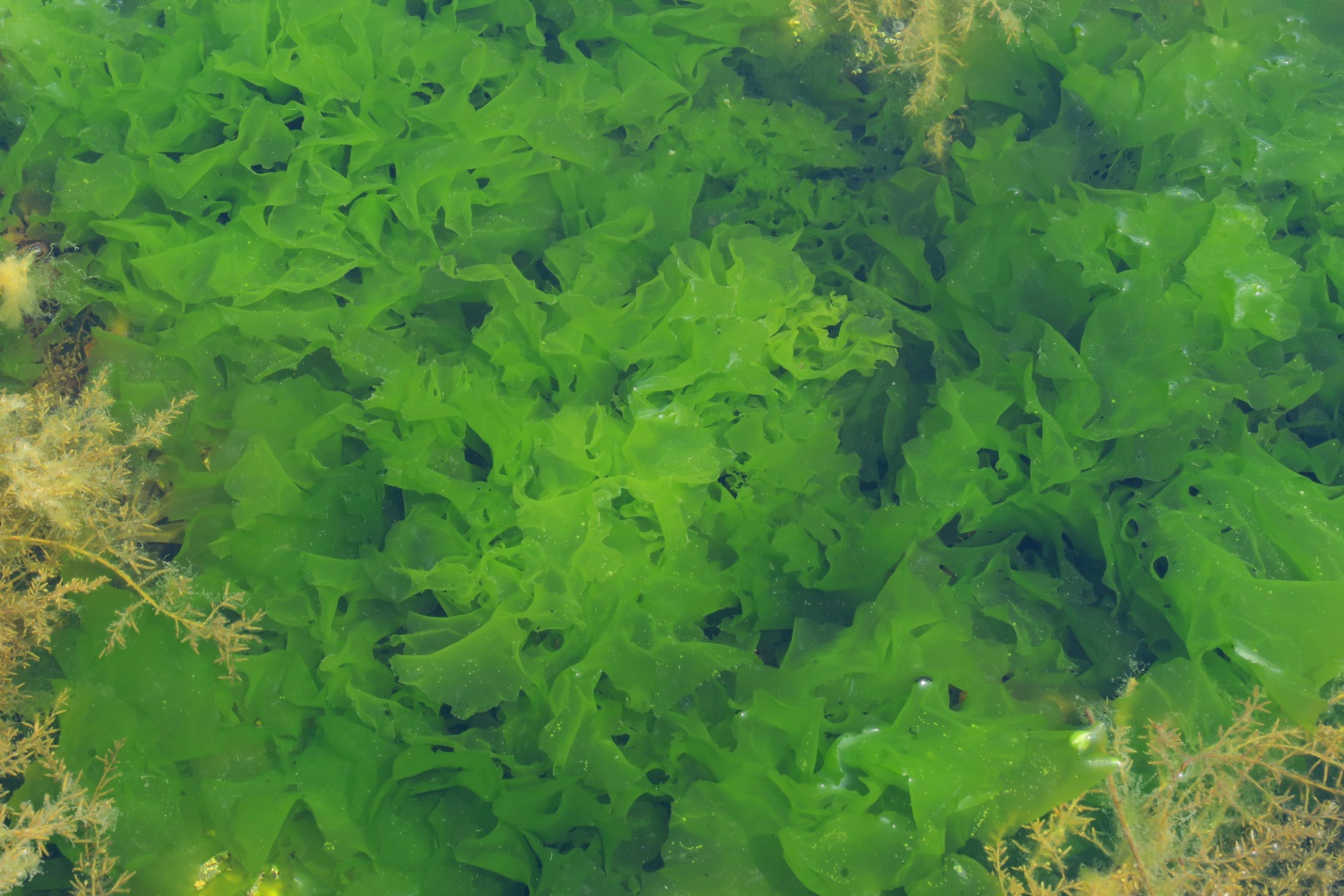
Figure 1: Viewed here in a large tide pool on a calm day, Ulva fenestrata does look very much like some leafy land plants of the “lettuce” variety! Point Holmes, Strait of Georgia, B.C., Canada. July 3, 2023. Photo ID 27577 ©Seaweedwhisperings.com
Person 1:
Bright green.
Seems to grow where not much else does.
Broad blades with ruffled edges.
Holes in blades..., faulty or deficient in rational thinking?
I recall that in sheltered bays, especially near urban run-off, it can become so prolific it forms a dense mass and smothers everything – not aware of consequences of that? Here at the exposed open beach at Point Holmes, Ulva fenestrata is not as prolific.
At rest in shallow water, blades radiate out in all directions, searching for the “right” answer.
Thin and fragile, unsure.
Subtle. Although it can dominate, it doesn’t do so aggressively, rather it slowly spreads.
There is lots of Sargassum around and floating above Ulva fenestrata. Ulva fenestrata doesn’t like the cover; wants to have full exposure to the sunlight.
Doesn’t do well when overshadowed by others.
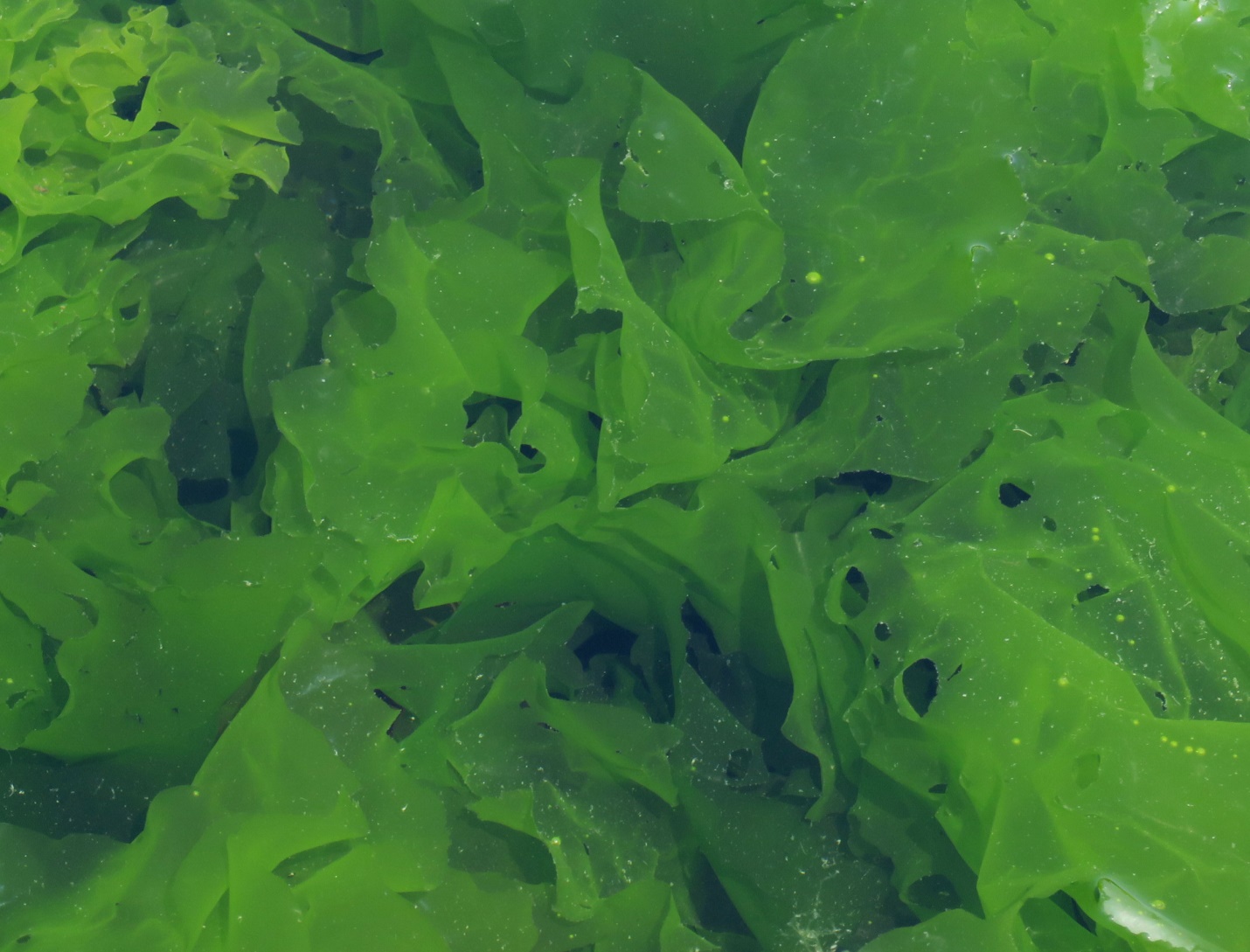
Figure 2: In this closer view some of the “Ulva holes” are visible in the foliose thalli – most notably on the right side of the image. Point Holmes, Strait of Georgia, B.C., Canada. July 3, 2023. Photo ID 27578 ©Seaweedwhisperings.com
Person 2:
After comparing and identifying many seaweed species exposed at this low tide, we came upon a large tide pool. In its depths were many, many Ulva fenestrata thalli growing profusely.
They are bright green and their ruffled layers give depth of shading to that green in a striking fashion.
Green – cool and rich with depths you cannot see.
The deepest parts are all covered by the flaring and gently ruffled blades that layer and float above.
You are not transparent, Ulva fenestrata, but just translucent enough that light flows right through you towards the depths.
In a few places I find holes in your blades – do they ensure that your blades don’t try to stand too erect, that you don’t grow too tall? I think that’s quite possible. Your blades are thin and would be like sails in the wind, easily torn if they were too upright or if there was no ‘escape hatch’ to relieve some of the force.
These holes must allow some water currents to move through you without moving the larger span of the whole blade; this results in giving a look that seems really quite calm and still – at least physically and on the exterior things look calm and still.
What does that stillness give?
Along with the translucence it gives you a great capacity to be layered. There are many, many layers to you – and no one layer seems to be favored over another.
Perhaps you are not so still and calm within...? Would you ever have enough folds and ruffles and layers to you, Ulva fenestrata? You seem to love to add to them indefinitely.
In areas where the water drains at low tide you flatten out in gentle folds of green, in a circle like some algal doily. If the day is hot or quite windy you become stiff and papery. You can handle the low tides but, oh my, how much more lovely it is for you to stretch your ruffles and float outwards – reaching and growing in the ocean waters.
You look like you can take advantage of new openings, new places to grow. Perhaps a quick “thanks” is given for the new territory and the opportunity it presents, and then you’re off – growing your green blades with untempered delight. Just pausing to take in the bright and fresh and filled-with-vigor “green” of this seaweed imparts some of this joyfulness.
In this tide pool there are some other algae. As compared to most of them, you float gently above – except with the Sargassum muticum. Its branches reach overtop of YOU, and where that happens you’re not so content, Ulva fenestrata. You don’t like to be influenced or obstructed in that manner as you definitely prefer to have your own clear view of the light. Sargassum isn’t intentionally cramping your style but it seems to be able to out-compete you or certainly block your best access to the full sunlight.
I became stiff, seated as was by this tide pool; wanted to stand up but then felt hesitation about doing so. Standing erect is not easy! Person 1 gave me a hand and even then I slipped and ended up back where I was, seated on my butt. “Thank you”, I said to Person 1, “but I believe I need to do this for myself”.
I wonder if Ulva fenestrata can find sometimes find its position to be uncomfortable, its traction a bit questionable, its reaching outwards posture rather difficult to effectively redirect? And in such situations I felt for myself its strong preference to sort out any such difficulties for itself. That feels best and also safest, as only Ulva knows where all its ‘limbs’ are and what they’re doing at any one time.
You don’t have one preferred direction to grow in Ulva fenestrata and so your rounded form results from the fact that you reach, pretty much equally, in all directions from your base. This is very different from other Ulva species nearby – one we looked at closely today grew in long ruffled strands; it picked its direction and went with it, putting everything into that.
It must feel very different to have the urge to grow out in ALL directions. Is that balanced, or does it at times feel like a conflict between bunches of good options? That in some cases (or in some directions) your energy is ironically actually opposing yourself? So, it then becomes a matter of which one to choose? And if it’s all directions..., then how to keep that in balance?
Are those holes in your blades possibly “blown through” when Ulva fenestrata is frustrated with the effort of balancing all its many options? Possibly so, because everything else in this seaweed looks so gentle and quite calm. There must be some places where tension and indecision leaves its mark.
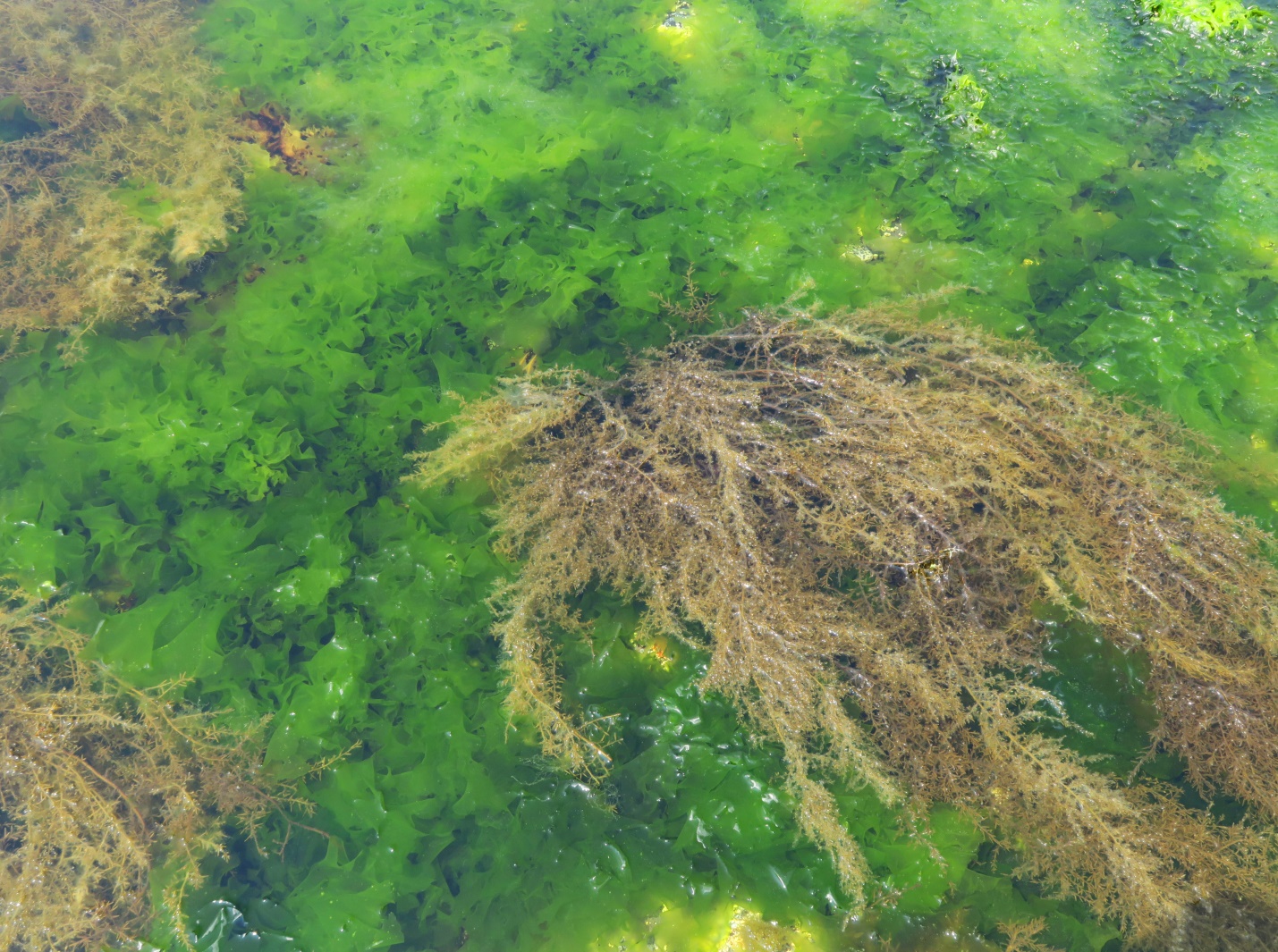
Figure 3: The large tide pool is seen here with its strong Ulva fenestrata population and also the ‘interloper’ – Sargassum muticum, which floats above aided by its countless small pneumatocysts. The Sargassum is quite bleached in this location, and the multi-branching stems are easily a couple of meters long. Point Holmes, Strait of Georgia, B.C., Canada. July 3, 2023. Photo ID 27579 ©Seaweedwhisperings.com
Post Field Events & Discussion:
While getting ready to transcribe our field notes, Person 2 wanted to first download a few photos from earlier today so they’d be available for us to re-immerse ourselves with. While doing this, we found photos of a species seen today that we had not been able to identify in the field. Without hesitation or word of “adieu” to our intended topic, we then set out on the tangent to discover more about this new seaweed. We were quite quickly able to resolve the identification issue. This was a delightful surprise, because in the field we had been puzzling over how we would confirm its name. The new seaweed is Fredericqia chiton..., a uncommon red alga we’d actually never knowingly observed in the field before.
It felt very clear to us that this “tangential exploration” was a part of the energy of the Ulva fenestrata Whispering. It was just one of the many directions we could go today, fueled as we were by the stimulation and information we gained through our experiences and images taken home from the seashore!
Possibly this kind of enthusiasm for tangential interests is one way that Ulva fenestrata diverts attention from itself, and therefore succeeds in remaining more hidden and not given full attention. But this “going in all directions” or “heading off on a tangent” trait obviously sometimes lands on interesting discoveries and Ulva certainly does enjoy that! At other times this Ulva fenestrata characteristic could simply result in gathering much in, along with some frustration or struggles or limited success in reaching any firm conclusions. There would often be the need to “shelve” that thought until further information can be gathered, and along with that a strong capacity for patience, too. This common struggle, however, does NOT deter Ulva fenestrata, and equally there is a deeply felt pleasure, quite possibly one that is accompanied with a touch of “surprise” when a clear resolution is found – when an investigation is completed satisfactorily.
Another example of following tangents came up yet again when doing web document preparation for this Whispering. In the middle of working on the document text and photos the author was happily diverted away from completing the original task, and set out to follow a couple of new research trails for another Ulva species (one that had been observed at the same location and on the same day as the Ulva fenestrata Whispering) and then even more tangentially, was inspired to pull out colored markers and draw highlights for key subjects on reference pages that were in frequent use (this also involved a short search to find the colored markers which had not been used for many weeks). All in all, it feels like there is something strong in this energy that can enjoy having multiple investigations or tasks going on in an overlapping fashion – very much like the overlapping broadly ruffled foliose form of the seaweed itself has many, many folds and layers – layers that are all connected, but not necessarily obviously so, even quite possibly, to Ulva fenestrata itself!
Maybe with Ulva fenestrata energy you can be contentedly working along on one topic (one of the smooth foliose surfaces of the blade), and then suddenly and rather pleasantly, you can fall through the “Ulva hole” (the round perforations in the blade) and find yourself now situated with quite a different topic altogether (another one of the smooth foliose surfaces). This could be endlessly fascinating, but it certainly feels like it can have significant consequences if one was serious about completing any one thing within a certain time frame.
Unlike the “rabbit hole” of Alice in Wonderland fame, the “Ulva hole” of Ulva fenestrata does not necessarily transport one to a surreal state. It seems that slipping through the “Ulva hole” could lead to most any other topic or task (at least that is our impression in this Whispering), and along with that task, one is led also to whatever state is best suited to serve its purposes.
There is another option that may occur for this type of energy and that is ‘peering through’ the “Ulva hole” to another layer, but also holding off on any ‘action’ to slip through! So, this situation could give awareness of other possibilities (seen through the hole), and might give rise to questioning and evaluating ones next course of action – slide through the hole to another layer, or not? Resisting falling through, though, feels like it might not be so common or so easy!
Reviewing the type of “tangents” followed while doing this write up, it seems that ‘falling through’ the “Ulva hole” can lead to quite notably different things. It was new resources from South Australia that were found as opposed to the more typically sourced references based in the earth’s northern hemisphere countries, and it was a change from digital creative efforts to actual pen and paper and colored ink hand drawing work...., so..., perhaps quite often these layers are really ones that are quite distinct from one another – from northern hemisphere to southern and from digital creation to hand generated efforts.
Are the “Ulva holes” sometimes portals to slip through and possibly by-pass or skip over what would be a slower and more linear path or progression from Layer A, to Layer B, to Layer C and so on? Quite possibly, “YES”, says the energy of this seaweed. There are depths to Ulva fenestrata that are quite astonishing, indeed, and they lay beneath a quite still and calm and beautifully cool green exterior.
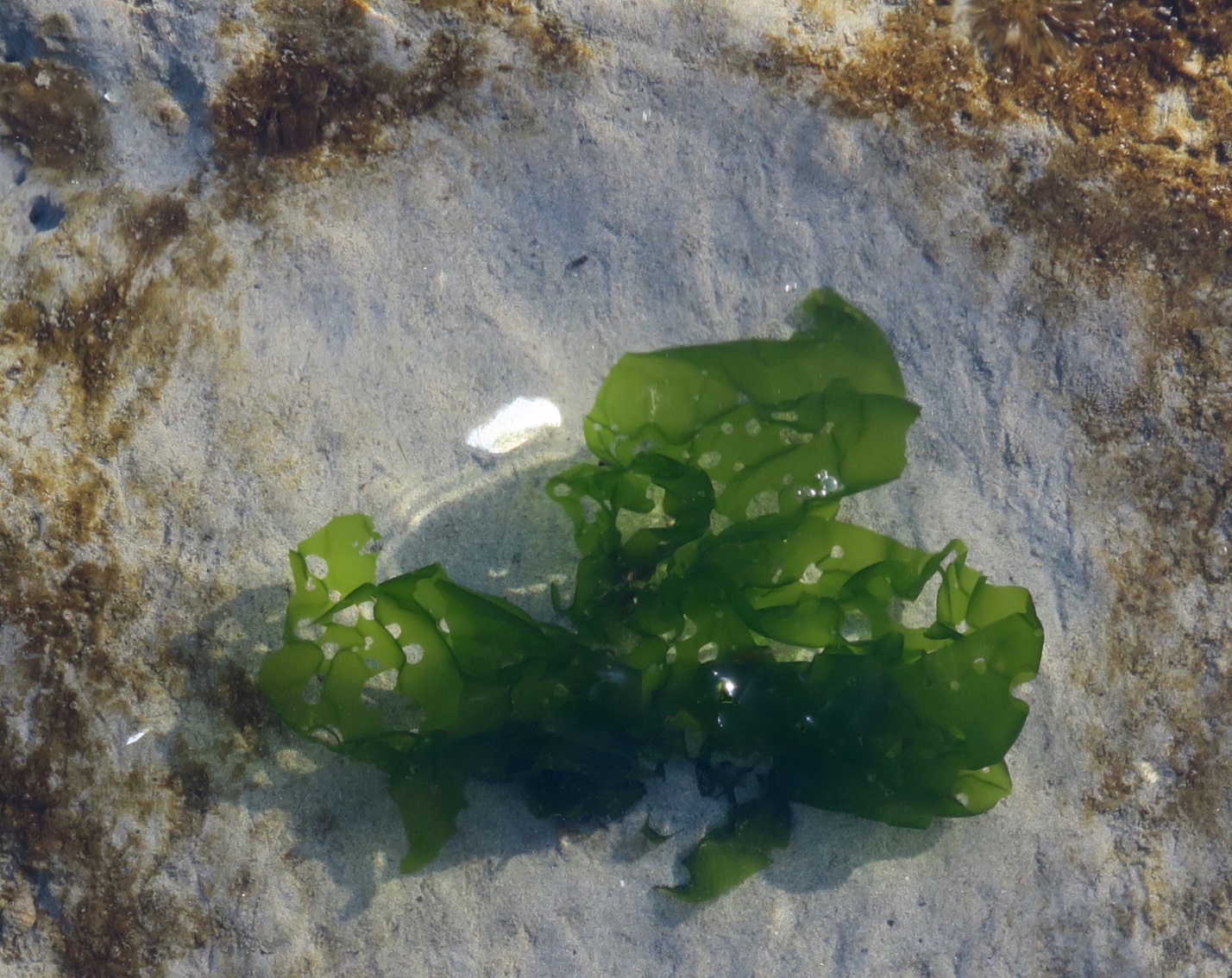
Figure 4: A single alga is shown here. It is anchored to a rock cobble that is buried in sand; this gives an uncomplicated background on which to view the many ‘holes’ in the thalli of Ulva fenestrata. In our observation the number and location of holes is random and varied. February 10, 2022. Gonzales Bay, Juan de Fuca Strait, B.C., Canada. Photo ID 27580 ©Seaweedwhisperings.com
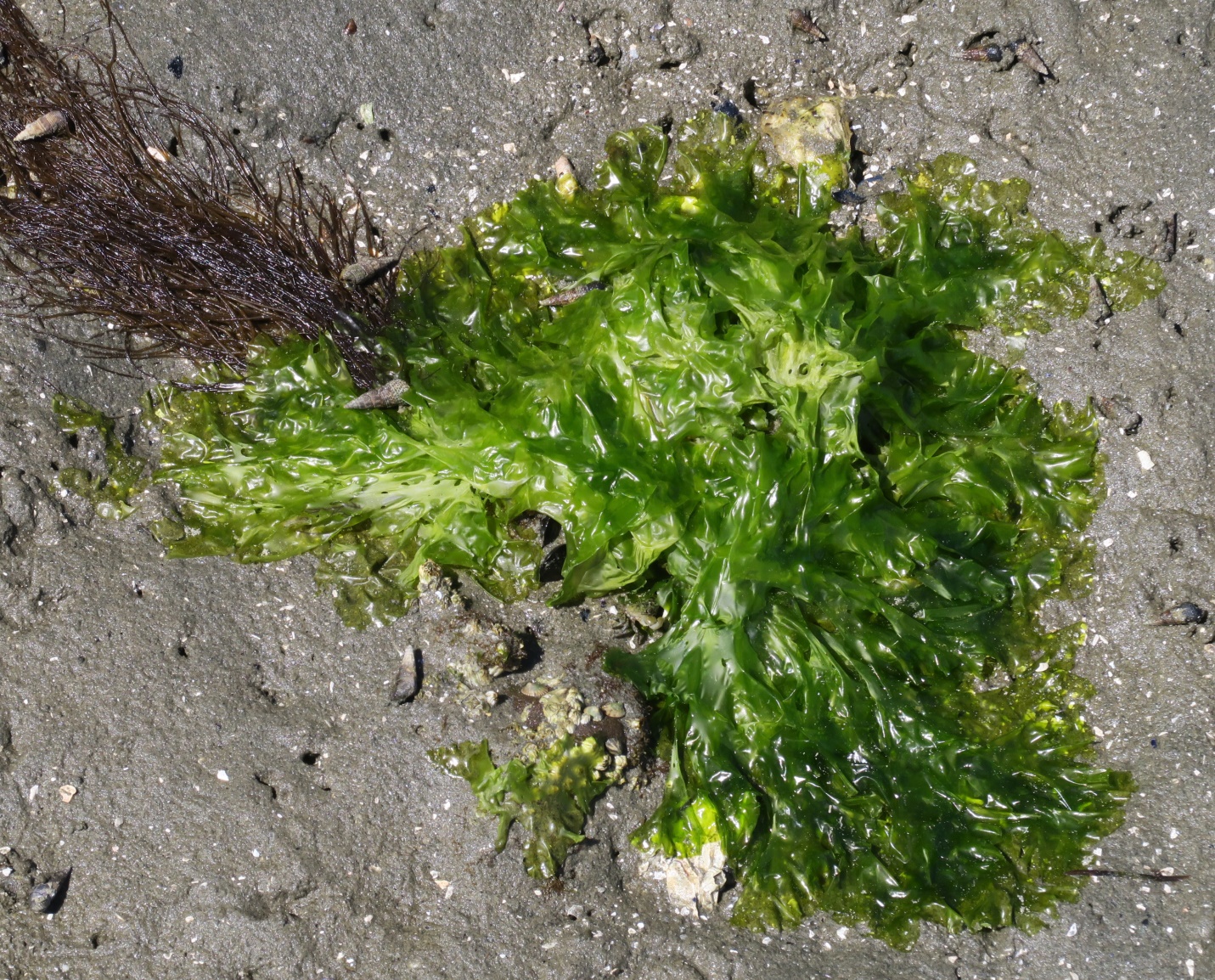
Figure 5: Ulva fenestrata is seen here collapsed on the mudflat beach at a very low summer tide. The many folds of the blades help in hydration efforts between tides. Interestingly the snails seem to be more interested in consuming the Gracilaria sp. seaweed (upper right) over the Sea Lettuce. Osborne Bay Beach, Strait of Georgia, B.C., Canada. July 1, 2023. Photo ID 27581 ©Seaweedwhisperings.com
Biology & Natural History Information:
Description:
Thallus is colored bright green and sometimes darker; it is smooth, very thin and supple as it is only two cell layers thick. Commonly the blade has numerous small holes or perforations throughout – these are the natural morphology of the species, not the result of herbivore grazing damage. Thallus can reach 60 cm (24 in) or more tall, but commonly is also much smaller. Cells are 10 – 20 µm thick, significantly thicker than Monostroma sp., another foliose green alga which can superficially look similar.
Habitat:
Ulva fenestrata occurs in the mid to low intertidal on cobble, boulders and bedrock. It prefers protected and semi-protected habitats and flourishes where there are rich nutrient concentrations.
North Pacific Distribution:
Coastal Alaska to California; China; Korea; Japan; Russia.
Remarks:
This species is reported to be very tolerant of a great range of temperatures. It can be seen out of water, looking quite dried out when the tide is low but rehydrates well. In suitably fertile areas summer blooms of this species can dominate shallow, sheltered bays often covering large areas. It grows quickly in shallow water locations as it is at these depths that its photosynthetic pigments, chlorophyll a and b, are most efficient.
The species name, ‘fenestrata’ is derived from the Latin meaning “window”.
Ulva lactuca is the type species of the genus Ulva. The species name is derived from the Latin for lettuce. The genus, Ulva, has 128 species and forms worldwide and it is arguably one of the most widespread of all seaweed genera, being found on all the coasts of the world. In the north Pacific region, the large bladed species are distributed from Alaska to Mexico.
For some years there have been taxonomic “discussions” over the name Ulva lactuca versus Ulva fenestrata. A review by Hughey et al (2019) reports that the “current usage of the name Ulva lactuca, the generitype of Ulva, remains uncertain.” It seems that for northern hemisphere, cold temperate Atlantic and Pacific species, the species which we interacted with in this Whispering, Ulva fenestrata is the earliest name and the correct one to use (Ulva stipitata is a junior synonym). Ulva lactuca is a warm temperate to tropical species, rather than the cold temperate species to which U. lactuca had been generally applied.
Classification:
Phylum: Clorophyta
Subphylum: Chlorophytina
Class: Ulvophyceae
Order: Ulvales
Family: Ulvaceae
Genus: Ulva
Species: Ulva fenestrata Postels & Ruprecht 1840
Former name(s):
Heterotypic synonyms: Ulva stipitata J.E.Areschoug 1850; Ulva lactuca f. stipitata (Areschoug) Kylin 1907.
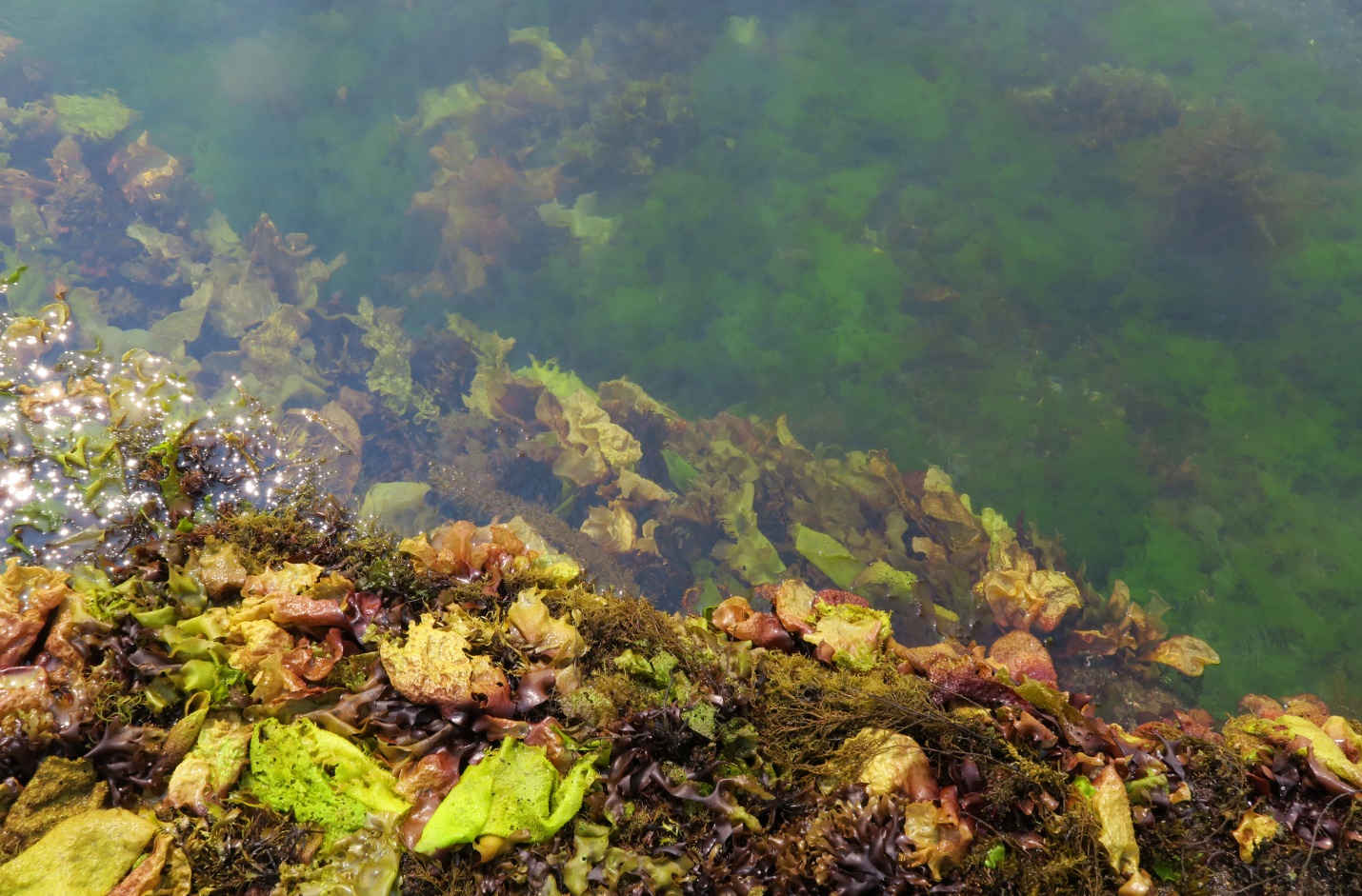
Figure 6: Pictured here are some rock ledges that are totally carpeted in macro algae. The first ledge (at the photo bottom) is above the current tideline; the second ledge is slightly immersed, and then deeper down at the next level there can be seen many ruffled blades of green. This is Ulva lactuca and it is doing best in the “depths” – as can be seen at this location it is more ‘prominent’ at the deeper bathymetry. Point Holmes, Strait of Georgia, B.C., Canada. July 3, 2023. Photo ID 27582 ©Seaweedwhisperings.com
![]()